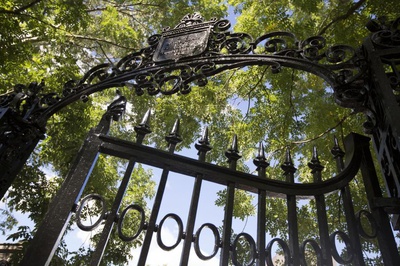
News
Nearly 200 Harvard Affiliates Rally on Widener Steps To Protest Arrest of Columbia Student

News
CPS Will Increase Staffing At Schools Receiving Kennedy-Longfellow Students

News
‘Feels Like Christmas’: Freshmen Revel in Annual Housing Day Festivities

News
Susan Wolf Delivers 2025 Mala Soloman Kamm Lecture in Ethics

News
Harvard Law School Students Pass Referendum Urging University To Divest From Israel
Harvard, I Have More Than Seven Friends
Tense conversations outside of Annenberg Hall. Hushed phone calls in the Lamont Library stairwells. A sense of despair permeating the first-year dorms. It’s that dreaded time of year again: housing season.
Blocking has long been a source of stress for many students. But the elimination of linking has only made things more cutthroat.
Deciding your blocking group hasn’t always been this bad. Before 2023, students could pick more than seven other friends to live near: They could “link” their group with another to be placed in the same house neighborhood. For years, proximity to the majority of your friends was practically guaranteed.
Then, it wasn’t.
The decision to get rid of linking came after a slew of historic changes. Each, interestingly, was apparently meant to make the housing system fairer and more equitable.
Originally, you essentially had to comp houses — interviews and applications included. Adams House was artsy, Kirkland House was for the jocks, and Eliot House was basically an unofficial final club. In 1971, housing applications and interviews were replaced with a ranking system, though students still clustered in relatively homogeneous groups. In 1977, the number of houses that could be ranked decreased from 12 to four, allowing for some uncertainty and house diversity as not every blocking group would receive their top choices. In 1995, the housing process was completely randomized, and the ability to submit preferences was eliminated entirely.
Each step led us to the egalitarianism we have today: Every student, no matter their background, has an equal shot at any house, leading to far more diverse residential environments. The decision to get rid of linking — though justified as an effort to make housing “more fair and equitable” — seems to be a step in the opposite direction. Now, the worrying exclusivity of certain houses has been replaced by the exclusivity of certain blocking groups.
Instead of students agonizing over being placed in a desired house, they worry whether they’ll make the cut for a suddenly much-smaller roster of potential blockmates. This week, a friend voiced concerns that a prospective blockmate might leave them for a “better blocking group.”
What makes one blocking group better than another? Wealth? Looks? Intelligence? Highest concentration of dazzling charisma and charm? With only eight spots, housing groups have become even worse breeding grounds for exclusion.
Thus, a twisted game of musical chairs is born. When one of the top blocks — think exclusive, think chic, think crème de la crème — has hit their eight person limit, someone has got to go. Their bottom dog gets sent down the ladder to the next block, whose respective #8 gets pushed even further down the rungs.
What you’re left with is utter chaos: constantly morphing groups, irrevocably changed friendships, and no idyllic inclusivity in sight. It’s hard to reconcile this state of affairs with Harvard’s stated aim of making housing more fair.
While the prospect of being 17th on someone’s list of future neighbors existed before linking got axed, having double the space significantly relieved supply constraints. It’s an Ec10 classic: blah blah supply blah demand.
Linking didn’t just preserve friend group harmony. Against the counsel of generations of freshman advisors, I’ve seen many hopeful freshman couples, in fear of a long distance, Currier House-Mather House relationship, turn to blocking for reassurance.
Is it worth risking three years of bumping into your ex on the way to the bathroom, armed with nothing but a bathrobe and CVS shampoo? I don’t know — luckily, the perfect workaround existed: linking, wherein your lover would be close, but not too close, just in case there wasn’t the happiest of endings.
Now, that solution is gone. Harvard is condemning a generation of young lovebirds to choose between the aches of separation, or years of awkward damnation.
The loss of linking is bigger than hurt feelings and petty politics. It is a threat to espoused ideals of fairness, a reversal of a long historical process toward inclusivity, and a slap in the face to Harvardian norms of courtship.
In short, no link needs a rethink.
Margot I. Cerbone ’28, a Crimson Editorial editor, lives in Canaday Hall. She really hopes this article doesn’t get her quadded
Want to keep up with breaking news? Subscribe to our email newsletter.
Related Articles
Most Read
- 2 Years After Affirmative Action Ruling, Harvard Admits Class of 2029 Without Releasing Data
- Harvard Suspends Research Partnership With Birzeit University in the West Bank
- Give the Land Up — Or Shut Up
- More Than 600 Harvard Faculty Urge Governing Boards To Resist Demands From Trump
- Russian HMS Researcher Detained at Louisiana ICE Facility After Visa Revocation
From Our Advertisers

Over 300+ courses at prestigious colleges and universities in the US and UK are at your disposal.

With innovative financial tools combined with financial education, Collegiate empowers students to take control of their finances and build confidence in their money management skills.

Serve as a proctor for Harvard Summer School (HSS) students, either in the Secondary School Program (SSP), General Program (GP), or Pre-College Program.

With an increasingly competitive Law School admissions process, it's important to understand what makes an applicant stand out.

Welcome to your one-stop gifting destination for men and women—it's like your neighborhood holiday shop, but way cooler.

Admit Expert is a premium MBA admissions consulting company, helping candidates secure admission to top B-schools across the globe with significant scholarships.

